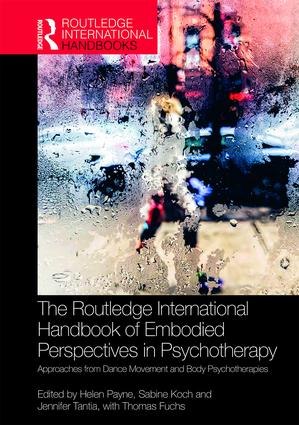 What do you get when four seasoned academics combine their scholarly resources and put their pens to the page?
What do you get when four seasoned academics combine their scholarly resources and put their pens to the page?
An impressive “fertile intersection of fields of inquiry” with a star-studded list of contributors writing about body psychotherapy and dance movement therapy.
This 400 plus page anthology highlights ways for clinicians to immerse themselves and their clients into the “silent worlds of sensing, touching, moving, breathing, and feeling” via psychoanalytic thought, cognitive science, and phenomenological views.
The Routledge International Handbook of Embodied Perspectives in Psychotherapy: Approaches from Dance Movement and Body Psychotherapies (2019) edited by Helen Payne, Sabine Koch, Jennifer Tantia, with Thomas Fuchs, is a valuable addition to our current literature.
It is divided into three sections: Essential dimensions of being a body; theory and practice in dance movement psychotherapy; and theory and practice in body psychotherapy. The editors co-authored an in-depth description of embodiment then clarified two disciplines -dance movement psychotherapy, also known as dance movement therapy and dance therapy, and body psychotherapy-as they pertain to psychotherapy.
They introduce each section and offer a summary of the material that follows. There are three forwards as well, written by Don Hanlon Johnson, Vassiliki Karrou, and Babette Rothschild. All material presented is well written and well edited. It is a comprehensive reference book- clearly academic but fleshed out, personal despite the movement from anecdotal to evidence- based generalities. The chapters are interesting to read. Although some of the information has been presented in other publications-the contributors are well established in their line of inquiry-most appeared to offer fresh perspectives on their foundational line of thought.
As noted, many of the contributors are active in our field as researchers, clinicians, teachers, presenters, and writers: Maxine Sheets-Johnstone, USA; Shaun Gallagher, USA; Jennifer Tantia, USA; Tina Stromsted, USA; Amber Gray, USA; Suzi Tortora and Jennifer Whitley, USA; Helen Payne, UK; Gill Westland, UK; Halko Weiss and Maci Daye, Germany; Nick Totton, UK; David Boadella, Switzerland; Michael Soth, UK; Ulfried Geuter, Germany; Michel Coster Heller and Gillat Burckhardt-Bartov, France; Tom Warnecke, UK; Asaf Rolef Ben-Shahar, Israel; Rae Johnson, USA; Christine Caldwell, USA; Michael Changris, USA; and Maurizio Stupiggia, Italy.
There are also a number of names new to this reviewer who offer a refreshing take on research and clinical applications including: Margit Koemeda-Lutz, Switzerland; Helma Mair, Ireland; Ursula Bartholomew and Ingrid Herholz, Germany; Iris Brauninger, Switzerland and Radwa Said Abdelazim Elfeqi, Egypt; Rainbow Ho, Hong Kong; Miyuki Kaji, Japan, Teresa Bas, Spain, Diana Fischman, Argentina, and Rosa M Rodriquez, Spain; Haugit Ehrenfreund, Switzerland, Alexander Girshon and Ekaterina Karatygina, Russia; Sylvie Garnero, France; Susan D. Imus, USA; Rosemarie Samaritter, The Netherlands; Annette Schwalbe, UK and Kenya; Marianne Eberhard-Kaechele, Germany; Johannes Michalak, Naomi Lyons and Thomas Heidenreich, Germany; Diana Cheney, UK; and Jessica Acolin, USA.
The content ranges from narratives in embodied therapeutic practice to a model for conceptualizing and treating mental illness. One chapter offers a developmental taxonomy of interaction modalities in dance movement therapy, another looks at somatic body mapping with women during life transitions. There’s information on the development of the self (body) in dance movement therapy. You can learn how dance movement therapy can contribute to suicide prevention and work as a restorative modality with survivors of relational trauma. The insights from Japan and Hong Kong as well as Swiss and Egyptian perspectives on dance movement therapy-embodiment of space in relation to self and others as well as stillness and movement in different cultures- is fascinating.
Within the section on body psychotherapy, chapters relate to embodied-relational therapy, relating through the body, and functional relaxation in psychosomatic medicine. Biosynthesis therapy, emotional regulation, oppression and embodiment, safety in psychotherapy, touch and embodiment, and research-informed body psychotherapy clinical work are addressed.
When confronted with reviewing a “handbook”, I think it’s best to give a general sense, let readers know, hey, this is worth checking out. It isn’t a sit down and read it all at once book. It is meant to be a resource. A place to come for current insights into dance movement therapy and body psychotherapy that are supported by research and personal clinical experience. I appreciated the opportunity to immerse myself in the text over the summer, time to be with chapters and explore what resonates for me, what feels applicable to me and what challenges me so I can continue to grow and stretch beyond my comfort zone and embrace new perspectives.







